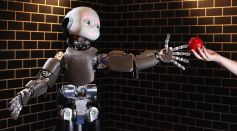TECH & INNOVATION

Men Using Photos of Children, Dogs, Other Pets in their Profile Seek Long-Term Partners

Groundbreaking Research Produces Record Levels of Strain in Single-Crystal Silicon, Which Could Lead to Phones with Smoke Detector Technology

Meet iCub: Iron Man-Like Robot Designed for Search and Rescue Missions During Natural Disasters

5G Technology Feared to Disrupt Flight Signals, Airlines Appeal to FAA to Take Action

This Chinese Restaurant Perfected Contactless Service Through AI-Powered Robots, Solves Staff Shortage During Pandemic

JAXA Develops Culture Bag for Crop Production and Long-Term Food Supply in Space

China Builds Artificial Moon Using Floating Frog Experiment's Magnetic Levitation To Stimulate a Low Gravity Environment

Chemical Compounds Found in Drinking Water Known To Cause Cancer, Heart Disease, Other Conditions Could Be Removed Using New Technology

Most Detailed 3D Map of the Universe Showcases 7.5 Million Galaxies Surveyed Using 5,000 Telescopes

Cartilage Regrowth May Help With Arthritis Treatment, Healing Joints Thru a Knee Implant That Conducts Electric Current

Teenage Hacker In Control of Over 20 Tesla Vehicles in Several Countries Using Software to Operate the Cars Even Without Keys

People Spend an Average Of 4.8 Hours On Smartphones as the World Embraces New Mobile Lifestyle, Study Says

Pharmactive Ramps up Its Sustainability Policy
Boston Scientific to Present New Data on Advances in Chronic Pain Care at the 2022 North American Neuromodulation Society (NANS) Meeting
Most Popular

Can the World Run Out of Water? Water Scarcity Science and Climate Impact Explained

Solar Maximum 2026: Inside the Sunspot Cycle and Solar Activity Forecast Astronomers Are Watching

Volcanic Warning Signs: How Magma Movement Reveals Eruption Prediction Clues for Geologists

Could Technology Prevent Natural Disasters? How Disaster Prediction and Early Warning Systems Could Save Lives





